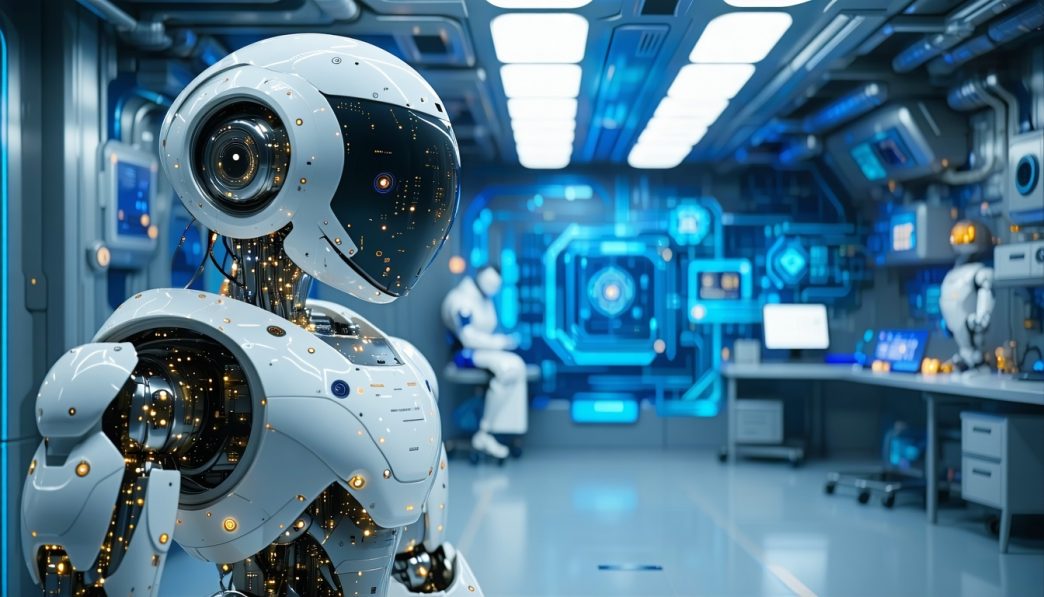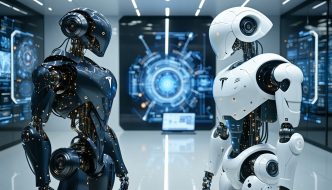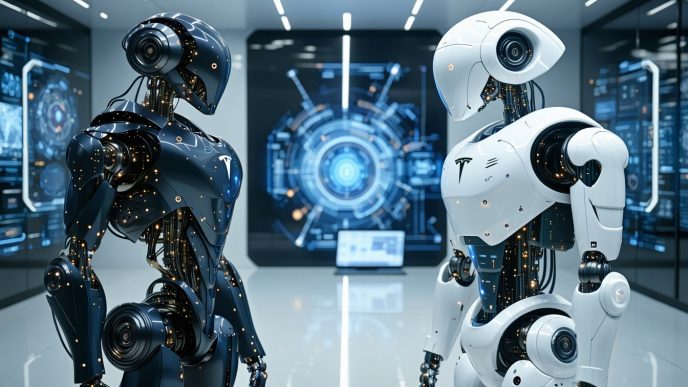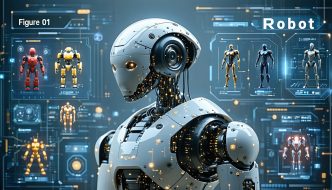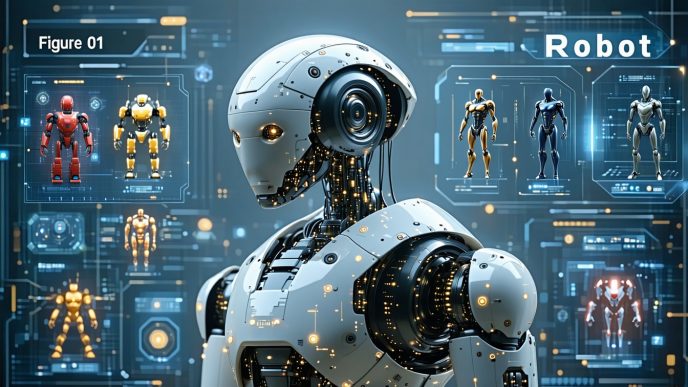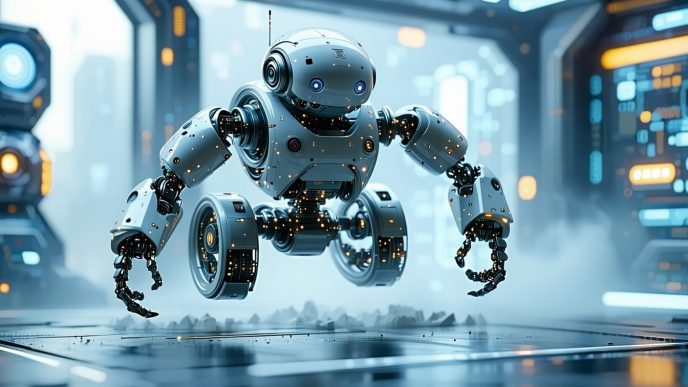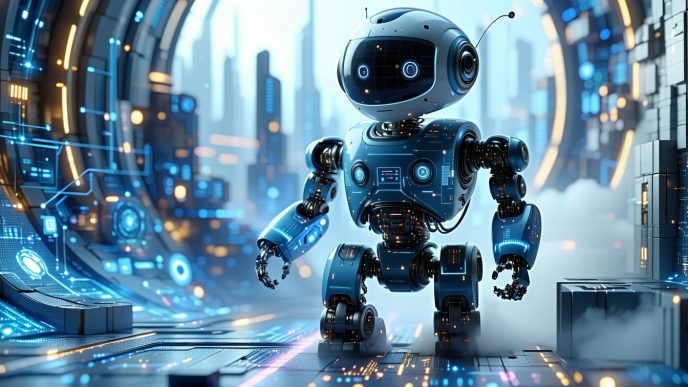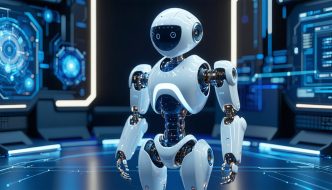Introduction to Humanoid Robots
Humanoid robots serve an essential role in the advancement of robotics and artificial intelligence. Their design mimics human appearance, behavior, and capabilities, allowing them to interact seamlessly with people in various environments. As these robots become increasingly sophisticated, they hold significant potential for applications in multiple sectors, including healthcare and education.
Understanding the Role of Humanoid Robots
The primary role of humanoid robots is to assist and enhance human tasks. By mimicking human gestures and communication styles, these robots can effectively engage with individuals in their daily routines. They are designed to incorporate advanced technologies, such as artificial intelligence and machine learning, enabling them to learn from interactions and improve over time.
The inclusion of humanoid robots in various fields offers unique opportunities. In healthcare, for example, they can assist medical practitioners by performing tasks such as patient monitoring or providing companionship to the elderly. In educational settings, they can be used as interactive teaching aids, helping to facilitate learning experiences. Moreover, they present solutions for various other applications, including security and logistics.
Importance of Modular Design in Robotics
The modular design of humanoid robots, including models like the apptronik apollo, plays a crucial role in their functionality and adaptability. Modular robotics allows the breakdown of the machine into various components or sections, making it easier to develop, repair, and upgrade specific parts without affecting the entire system.
This design approach has several advantages:
| Advantage | Description |
|---|---|
| Flexibility | Modular systems can quickly adapt to different tasks by swapping out components. |
| Scalability | New technologies and features can be added through the incorporation of new modules, allowing continuous improvement. |
| Maintenance | Repairing or upgrading one module does not necessitate downtime for the entire robot, enhancing efficiency. |
Overall, the modular design philosophy supports the pursuit of innovative robotics, contributing to the evolution of humanoid capabilities. For more insights on specific humanoid robots, explore articles on various models such as Tesla Optimus, Xiaomi CyberOne, and Sanctuary AI Phoenix. The development of humanoid robots continues to evolve and reshape industries, paving the way for new technologies and solutions.
Apptronik Apollo: An Overview
The Apptronik Apollo represents a significant advancement in humanoid robotics. It is designed to operate effectively in various environments while demonstrating human-like capabilities. This section outlines the key features of the Apptronik Apollo and its potential applications across multiple sectors.
Features of Apptronik Apollo
The Apptronik Apollo boasts a range of features that enhance its functionality and adaptability.
| Feature | Description |
|---|---|
| Modular Design | Allows for easy upgrades and customization. |
| Advanced Sensors | Equipped with sensory systems for better interaction and navigation. |
| Artificial Intelligence | Incorporates AI for improved decision-making and learning capabilities. |
| Versatile Movement | Capable of complex movements mimicking human actions. |
| Human-Robot Interaction | Designed to communicate effectively with humans using voice and gestures. |
The modular design of Apptronik Apollo enables users to alter its components based on specific needs, making it a versatile choice for various applications. The integration of advanced sensors enhances its ability to interact with the environment, a critical aspect for tasks requiring precision and responsiveness.
Applications of Apptronik Apollo
The Apptronik Apollo is versatile and can be applied in numerous fields, each benefiting from its unique capabilities. Some potential applications include:
| Application Area | Description |
|---|---|
| Healthcare | Assisting in patient care and rehabilitation tasks. Explore more in our article on humanoid robots in healthcare. |
| Education | Offering interactive learning experiences. For insights, see humanoid robots for education. |
| Logistics | Streamlining warehouse operations and delivery systems. More details can be found in humanoid robots in logistics. |
| Companionship | Providing social interaction and support for individuals. Learn more in our section on humanoid robots for companionship. |
| Elder Care | Enhancing the quality of life for elderly individuals. See our exploration of humanoid robots in elder care. |
These applications illustrate the Apptronik Apollo’s potential to transform multiple industries, making significant contributions to efficiency and improving human experiences. With its advanced features and multifunctional capabilities, it stands out as an important player in the evolving field of humanoid robotics.
Modular Design in Robotics
Modular design plays a vital role in the development and functionality of humanoid robots, such as the Apptronik Apollo. This approach allows for flexibility and adaptability in building robots that can efficiently serve various purposes.
Advantages of Modular Robotics
Modular robotics offers several key benefits:
| Advantage | Description |
|---|---|
| Customization | Components can be tailored to specific tasks or applications, enhancing robot functionality. |
| Ease of Maintenance | Individual modules can be easily replaced or repaired without the need for complete disassembly. |
| Upgradability | Robots can be upgraded by swapping out old components for newer technologies, ensuring longevity. |
| Cost-Effective Solutions | Reduced costs for replacements and repairs by allowing partial updates rather than full replacements. |
These advantages contribute to a more effective and efficient workflow in both development and operation stages of humanoid robots.
Versatility and Scalability in Humanoid Robotics
The modular design of humanoid robots also promotes versatility and scalability. This adaptability enables the robot to perform a wide range of tasks across various environments. For example, the Apptronik Apollo can be customized for specific applications, such as healthcare or industrial settings.
| Feature | Benefit |
|---|---|
| Task Variety | Different tasks can be accomplished by adjusting or swapping modules, such as sensors or arms. |
| Scalability | Robots can be scaled to meet the demands of various operations, from small units to larger systems. |
| Interchangeable Modules | Modules can be interchanged quickly, allowing for rapid deployment in different scenarios. |
The ability to address diverse needs makes modular humanoid robots increasingly valuable in various sectors. For a deeper understanding of how humanoid robots operate in different environments, refer to our articles on humanoid robots in healthcare and humanoid robots for education.
Components of Apptronik Apollo
Understanding the components of Apptronik Apollo is essential for grasping its capabilities and efficiency as a humanoid robot. This section focuses on the structure and materials used in its construction, along with its sensory systems that enable interaction with the environment.
Structure and Materials
Apptronik Apollo boasts a robust and versatile structure designed for various applications. The materials used in its construction include advanced alloys and composites that ensure a lightweight yet durable framework. These materials not only provide structural integrity but also enhance the robot’s agility and responsiveness.
| Component | Material | Description |
|---|---|---|
| Frame | Aluminum Alloy | Lightweight, strong, and resistant to corrosion |
| Joints | Reinforced Plastic | Flexible yet durable to allow for movement |
| Covering | Carbon Fiber Composites | Provides protection and decreases weight |
The robot’s design incorporates a modular approach, allowing for easy maintenance and upgrades. This structure makes Apptronik Apollo suitable for various environments, whether in industrial, healthcare, or domestic settings. For a look at other humanoid robots that utilize innovative structures, check our article on humanoid robots for home use.
Sensory Systems
The effectiveness of Apptronik Apollo largely hinges on its advanced sensory systems, which enable it to perceive and respond to its environment accurately. These systems consist of a variety of sensors that contribute to its functionality and effectiveness.
| Sensor Type | Purpose | Feature |
|---|---|---|
| Cameras | Vision capabilities for navigation | High-definition imaging for object recognition |
| LIDAR | Autonomous navigation and mapping | Scans environment in 360 degrees |
| Proximity Sensors | Detects nearby objects to prevent collisions | Helps navigate complex spaces efficiently |
| Microphones | Sound detection for interactive communication | Allows for voice interfaces and commands |
These sensory features allow Apptronik Apollo to interact effectively with humans and adapt to dynamic environments. The comprehensive integration of sensory systems also makes elements like voice interfaces in humanoid robots a critical component for real-time communication and assistance.
Understanding both the structural components and sensory capabilities of Apptronik Apollo will provide insight into its potential applications and functionalities in various fields.
Functionalities of Apptronik Apollo
The Apptronik Apollo humanoid robot is designed with advanced functionalities that enhance its performance in various environments. Key areas of focus include movement capabilities and interaction features.
Movement Capabilities
Apptronik Apollo boasts impressive movement abilities that enable it to navigate complex environments effectively. This robot is equipped with advanced locomotion systems that mimic human movement patterns. It can walk, run, and even use stairs, showcasing its versatility.
| Movement Type | Description |
|---|---|
| Walking | Capable of smooth walking with precise foot placement. |
| Running | Designed to adjust stride length and speed dynamically. |
| Stair Navigation | Implements a stair navigation system for better mobility. |
The robot’s sophisticated balance control system helps maintain stability during movement, allowing it to handle various terrains and obstacles efficiently. This capability is vital for tasks in real-world situations such as healthcare and industrial applications, making it an essential feature for service tasks.
Interaction Features
Interaction is another crucial aspect of the Apptronik Apollo. The robot is designed to engage and communicate with humans effectively. Its interaction features include:
| Feature | Functionality |
|---|---|
| Facial Recognition | Identifies and remembers faces for personalized responses. |
| Voice Interfaces | Utilizes voice interfaces in humanoid robots for user commands and queries. |
| Emotion Recognition | Capable of detecting and responding to human emotions, enhancing user experience. |
These interactive capabilities allow the Apptronik Apollo to assist in a variety of applications, from providing companionship to supporting healthcare professionals. The integration of sensory systems contributes to its ability to understand and respond to its environment, making it a significant advancement in humanoid robotics.
Integration and Programming
The integration and programming of humanoid robots like Apptronik Apollo are crucial for their functionality and effectiveness. These processes enable the robot to perform its designed tasks effectively and interact with users in a meaningful way.
Incorporating Control Systems
Control systems are the backbone of humanoid robotics, providing the necessary framework to manage the robot’s operations. Apptronik Apollo employs advanced control systems that allow for precise movement coordination and task execution. These systems enable the robot to interpret sensory feedback and execute complex commands, aligning with its intended applications.
A summary of key control system features in humanoid robots is outlined in the table below:
| Feature | Description |
|---|---|
| Sensor Integration | Combines data from various sensors for real-time feedback. |
| Motion Control | Allows for precise control of movement capabilities. |
| Task Management | Facilitates the execution of predefined tasks and adjustments based on user interaction. |
| Communication Protocols | Ensures seamless interaction between components and the external environment. |
Customization and Programming Options
Customization of humanoid robots is essential for meeting specific operational needs. Apptronik Apollo offers extensive programming options that allow users to tailor the robot’s functions. This adaptability is key for applications ranging from healthcare to industrial uses.
Programmers can utilize various software platforms and languages to develop custom applications. The flexibility in programming enables users to enhance features, such as interaction capabilities and task processing. A table displaying popular programming options is provided below:
| Programming Language | Usage |
|---|---|
| Python | Widely used for robotics programming due to its readability and extensive libraries. |
| C++ | Offers high performance, often used for real-time applications. |
| ROS (Robot Operating System) | Provides a flexible framework for writing robot software efficiently. |
| MATLAB | Utilized for algorithm development and simulation. |
The integration of sophisticated control systems combined with extensive customization and programming options allows Apptronik Apollo to adapt to various environments and user needs. This approach makes the humanoid robot a potent tool in various sectors, including healthcare and industry.
Real-World Applications
Humanoid robots like the Apptronik Apollo have a wide range of real-world applications. They not only enhance productivity in various sectors but also improve the quality of life in specific fields.
Healthcare and Medical Assistance
In the healthcare sector, humanoid robots can play essential roles in patient care and medical assistance. They assist in tasks such as patient monitoring, medication delivery, and rehabilitation support. The ability of humanoid robots to engage with patients provides a means of companionship, especially for those in elderly care.
| Application | Benefits |
|---|---|
| Patient Monitoring | Continuous observation ensures quick response to changes in patient condition. |
| Medication Delivery | Robots can transport medications to different departments, enhancing efficiency. |
| Rehabilitation Support | Assist in physical therapy exercises, providing motivation and guidance. |
| Companionship | Offer social interaction for elderly patients, improving emotional well-being. |
For further information on humanoid robots specifically designed for elder care, visit our article on humanoid robots in elder care.
Industry Applications
Humanoid robots like Apptronik Apollo are also making waves in various industries. They are used in manufacturing, logistics, and other sectors for tasks including assembly line work, quality control, and inventory management. Their adaptability allows them to be integrated into workflows, enhancing operational efficiency.
| Application | Benefits |
|---|---|
| Manufacturing | Streamlined assembly processes lead to increased output and reduced labor costs. |
| Quality Control | Robots can perform inspections with precision, minimizing errors. |
| Inventory Management | Efficient tracking of stock levels, reducing waste and improving organization. |
For applications of humanoid robots in logistics, check our article on humanoid robots in logistics.
Apptronik Apollo exemplifies the versatility and potential of humanoid robots in real-world settings. Their contributions span across multiple fields, showcasing their value and impact on modern society.
Future of Apptronik Apollo
Potential Developments
As the field of robotics continues to advance, the Apptronik Apollo is positioned to be at the forefront of future innovations. Developers are focusing on enhancing its artificial intelligence capabilities, which will improve its ability to interact with humans and adapt to various environments. This will likely include advances in voice interfaces and emotion recognition, allowing the robot to respond more intuitively to human needs.
Furthermore, potential developments may also focus on improving the modular design of the Apptronik Apollo. By expanding its range of interchangeable components, it can be customized for specialized tasks in different sectors, from healthcare to industrial applications. Future iterations may support enhanced sensory systems, incorporating more sophisticated robotic sensors to better navigate complex environments, a significant focus in humanoid robot navigation.
| Development Area | Anticipated Features |
|---|---|
| AI Enhancements | Improved interaction and adaptability |
| Modular Design | Expanded range of interchangeable components |
| Sensory Systems | Advanced sensors for enhanced navigation capabilities |
Impact on Robotics Industry
The Apptronik Apollo is expected to significantly impact the robotics industry by influencing trends toward modular and scalable designs. Its ability to adapt for various applications could set a new standard for humanoid robots, as other developers may strive to create robots with similar capabilities. This shift can foster greater investment in research and development, leading to innovative solutions across sectors.
The integration of advanced AI models and data analytics will also enhance the robotic functionality, potentially transforming how organizations utilize humanoid robots in workplaces. The introduction of these capabilities, alongside improved safety systems and ethics in robot interactions, aligns with growing societal demands for responsible technology. Insights into these facets can be further explored in articles like robot emotions and ethics and humanoid robots for daily chores.
With these developments, the Apptronik Apollo not only stands to advance its own functionalities but also encourages the robotics industry towards more ethical, efficient, and user-centric design paradigms.

